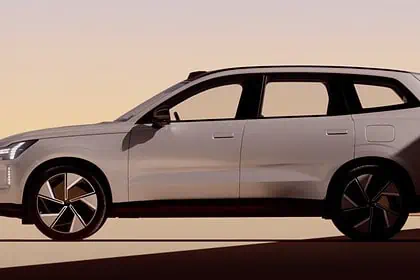The Netherlands is distinctive in several ways, primarily because the ocean defines its existence. Well, almost a third of the country is below sea level, forcing the Netherlands to devise novel ways to coexist with nature rather than bludgeoning it into submission as so many other countries do.
We previously noted an innovative dairy farm that levitates on the surface of Rotterdam’s harbor. That’s pretty inventive, but Amsterdam just opened a new bicycle parking facility near Centraal Station, the city’s central transportation hub. It cost $65 million to build and took four years, but that’s not the point of this story.
This building is submerged. The garage is constructed below sea level using methods perfected by generations of Dutch engineers. It even has escalators that transit bikes and riders between the garage and the street level.
The Verge contributor Thomas Ricker recently visited the new underwater parking structure. According to him, the project “has everything — and nothing — to do with automobiles.”
In a nation where bicycles smoothly outnumber citizens, the Global Cities Bicycle Index data shows that approximately 35% of Amsterdam residents ride their bikes daily. That figure rises to roughly half of all residents in Utrecht.
Transition to a more livable city
According to Ricker, Amsterdam’s transformation from an automobile-centric city to a multimodal transportation wonderland began in the 1970s. Private automobile ownership was demotivated in favor of clean and reliable car-sharing services that receive preferential treatment with the help of locals and educated politicians performing cooperatively for a more livable city.
Electric cars are not seen as a panacea in cities, where parking for any vehicle is nearly impossible. Building an underwater bicycle garage is just another example of how Dutch cities were methodically converting personal automobiles into relics of a misdirected past when cities were built around the necessities of cars rather than people.
Every day, approximately 200,000 people arrive at Amsterdam’s Central Station via rail, ferry, tram, bus, and subway, with half of them riding bicycles. Previously, abandoned bikes were a significant issue, but the new parking garage will track everybody who enters and leaves, which should significantly reduce the orphan bike problem.
The new facility, according to Ricker, is impeccable and has a distinct “2001: A Space Odyssey” vibe.
Benefits the daily commuters
Parking in the garage is free for 24 hours and €1.35 daily afterward. This is advantageous for everyday commuters and a fantastic motivator for people to remove their bikes quickly. To enter, you must either swipe your OV-chipkaart (a Dutch transport card linked to your bank account) or have a Fietstag (“bicycle tag”) attached to your bicycle.
The chipped tag is free for subscriptions and can be obtained inside the garage in just a few minutes.
A bike path on the street leads directly to the above-ground entrance, labeled by a large blue sign with a bicycle logo. If the lot is entire, the signal indicates how many parking spaces are available so riders can find an alternative—a pair of rolling beltways transit bikes and owners underground from the entrance.
The red and green lights on the vertical slats inside the garage indicate which lines of bicycle racks have open spaces. Once parked, an escalator at the garage’s far end provides direct access to Amsterdam’s Central Station.
Pieter Visser, the City of Amsterdam’s bicycle project manager, is incredibly proud of the new development’s architecture, lighting, and artwork depicting the city’s history.
It was a technical, very difficult bike park to build because it’s underwater, so that took a long time planning, and it took a long time to realize,
Some compare it to open heart surgery for the Amsterdam Central Station district. It’s quite an accomplishment,
Bike parking is now only allowed in the parking garages and not on the street, so the racks will be removed
Pieter Visser, Bicyle Project Manager of City of Amsterdam stated on the construction of underwater garage
More space for walks for Pedestrians
Previously, the above-ground bicycle racks were an ugly mess in a city that takes pride in its clean, modern appearance. Pedestrians will have much more area to walk around near the busy Central Station area once those racks are dismissed, which should occur in the next few weeks.
In February, a second submerged station for 4,000 bicycles, costing €25 million, will open behind the station on the IJboulevard.
The opening of the new [garages] marks the beginning of a new era in which Amsterdam Centraal Station becomes a bit like around 1900: accessible and enjoyable, without cars and bicycles parked everywhere and nowhere
The city stated in a statement about the opening of the underwater station
The new bike parking garages are part of a more significant renovation of the area, including jetties and bridge maintenance, wider walkways and cycling routes, and track and cable replacement.
Amsterdam is a symbol of urban mobility
According to Thomas Rickers, the parking garage could be more flawless.
There is no designated parking for cargo bikes, which are common in Amsterdam for families with small children. There also aren’t any charging points for e-bikes, which is a real oversight in a country where more than half of all new bicycles sold are electric,
It can easily be stolen and used by anyone to surreptitiously check in or out of the garage, with all bills automatically charged to my account,
Nevertheless, these are such minor nitpicks that I’m almost ashamed to mention them. But modern cities like Amsterdam only arrived at this point though decades of continuous improvement. The project around Centraal Station might have started in 2019, but its foundation was laid long ago,
Granted, not every city can be like Amsterdam,But even new bicycle cities like Paris have proven that if you build the lanes, the bicyclists will come
Thomas Ricker stated on parking garage infrastructure
You have to begin somewhere, just like the transition to electric vehicles. As EV charging infrastructure is required to propel the EV revolution forward, convenient, safe bicycle parking is needed to persuade more people to ride their bikes into town instead of driving a car.
Amsterdam has produced a symbol of urban mobility that will encourage other cities worldwide to emulate.






